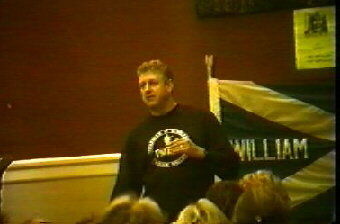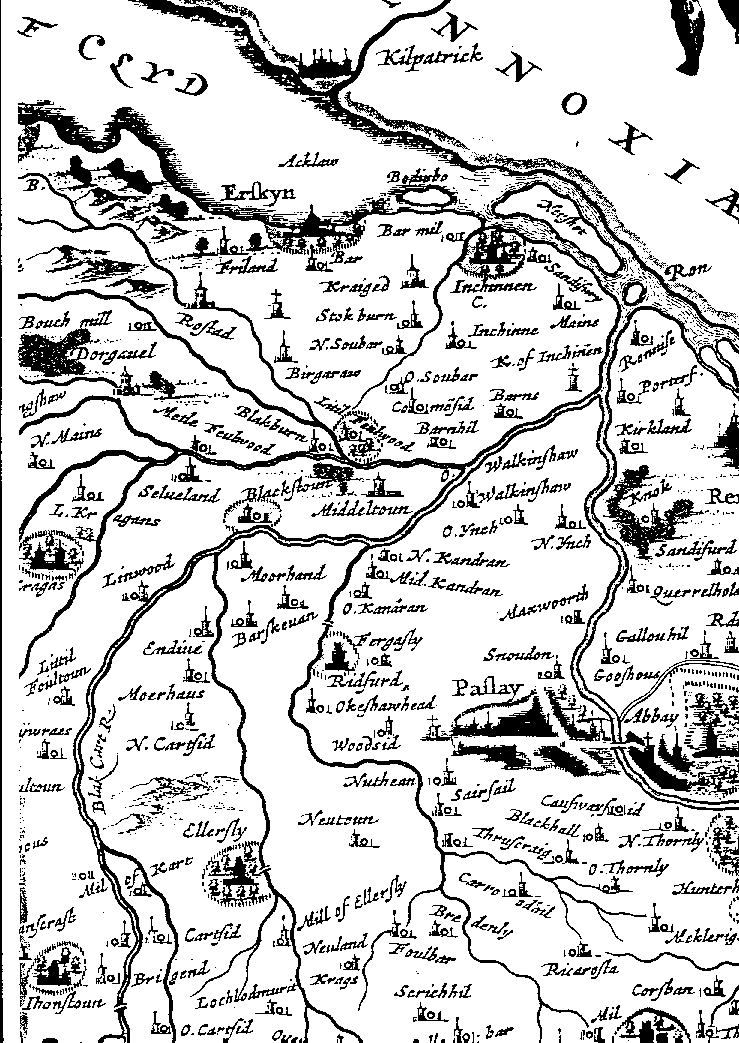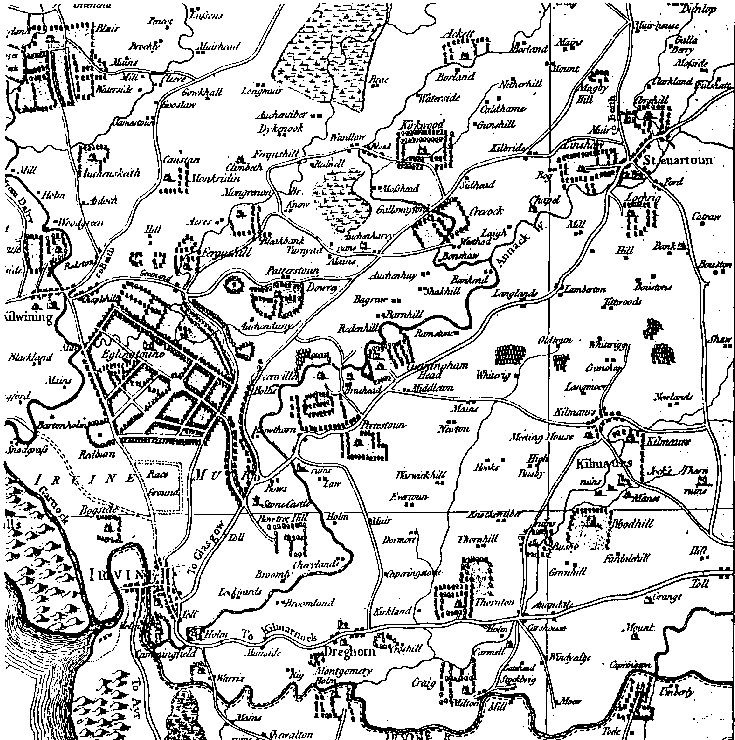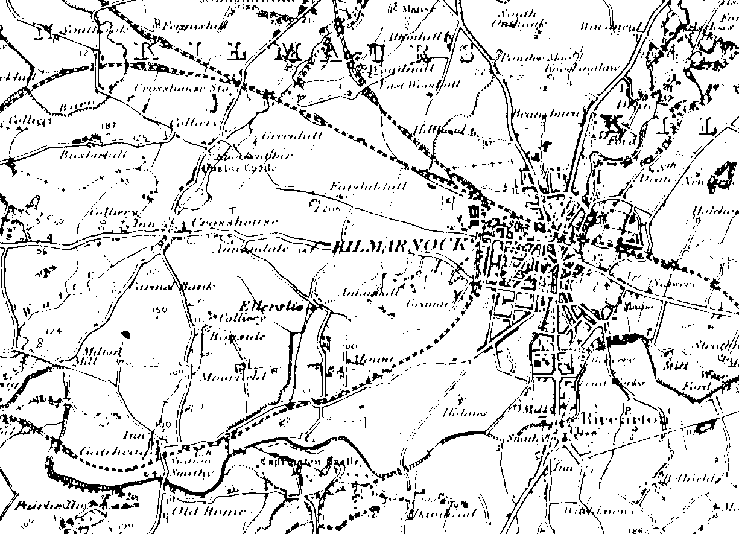The following notes and three maps were sent to us in September, 1997, by David Ross of the Society of William Wallace (seen addressing the Society meeting at the 1997 Braveheart Convention in the photograph on the right).

MacBRAVEHEART ... Sir William Wallace of Elderslie
| The case for Elderslie as the birthplace of Sir
William Wallace ... The following notes and three maps were sent to us in September, 1997, by David Ross of the Society of William Wallace (seen addressing the Society meeting at the 1997 Braveheart Convention in the photograph on the right).
|  |
SIR WILLIAM WALLACE OF ELDERSLIE
Over the last few years, one or two writers have made claim over Wallace hailing from Ayrshire. As
this data seems to be receiving more and more credit, I, on behalf of the Society of William Wallace,
would like to lay down some sort of semblance of the truth for interested parties to peruse at leisure.
Many Ayrshire claims have been based around Craigie Castle, or various documents pertaining to that
establishment. The ruins of this edifice stand near the village of Craigie, which lies between
Kilmarnock and Ayr, close to the A77.
This castle was a Wallace property, but not before 1371, when a Wallace, John by name, married the
Lindsay heiress who had inherited Craigie, and so acquired the property and title.
As William Wallace the patriot was born sometime around 1270, the impossibility as his birthplace is
obvious.
In fact, William Wallace is known in history as the Knight of Ellerslie or Elderslie. Both these names
are one and the same - both mean the field of the Elder trees, and Elderslie of course stands close to
Paisley in Renfrewshire.
Where this mis-understanding has occurred is the fact that there is a house by the name of Ellerslie
near Kilmarnock, and claims have been made by some hard bending of the facts that this was William
Wallace’s birthplace. The fact is that this house does not appear on maps as Ellerslie before 1835,
and as it was attached to a small colliery and brickworks, the chances are that it was named by a
patriotic owner.
We do know that the Wallaces were vassals of the High Stewards of Scotland.
Renfrew today is known as "The Cradle of the Stewarts". In fact all the High Stewards are buried in
Paisley Abbey. This family came north from Shropshire on the Welsh Marches in the time of David I
of Scotland.
The original form of Wallace meant "Welsh Speaking", and we know that William's ancestors
followed these "Stewards" north as their vassals. In 1174 one Richard Wallace, who is generally
regarded as being William's ancestor, witnessed a charter to the Abbey of Paisley. The Wallaces were
granted the lands of Elderslie sometime before 1250.
We know that the Wallace family have always had some kind of fortified dwelling at Elderslie. The
ruins which stand there today date only as far back at the 1500's, but as a house adjoining this site is
called the Moat House (ancient fortified dwellings were known at Mottes or Motte Houses), the house
in which William was born could have occupied either of these sites.
The bottom line in all this is that there is absolutely no evidence whatsoever that the Wallace family
owned at any time the lands near Kilmarnock which now contain the later house know as "Ellerslie".
There are no remains of early buildings or records of them on this site. Some confusion arises
because the historian John Major referred to Wallace - albeit more than 200 years after this death - as
the "King of Kyle", Kyle being an area of Ayrshire, but the Kilmarnock "Ellerslie" actually stands in
the area known as Cunningham, but this has not deterred some from claiming it as his birthplace. The
Stewards owned land in Kyle, so perhaps this is where Major’s history is mistaken. Intriguingly, Kyle
is a corruption of the Gaelic word for a wood, Coille (pronounced Kyle), so perhaps Major was right
in naming him King of Kyle or King of the Forest, as we know Wallace based himself in the great
forests of that time.
At the Elderslie, Renfrewshire site, two famous trees once stood, the Wallace oak, and the Wallace
Yew. The yew alone remains. Some doubt has recently been cast on the antiquity of this tree, but
parish records from the 1700's refer to it as "this ancient tree".
As the oldest tree in Europe is a yew which stands in Fortingall in Perthshire and is over 3,000 years
of age, it is interesting to think that this tree is named the Wallace Yew for other than the site of its
location.
The famous Wallace Oak which is claimed to have afforded shelter to William and his followers from
an English patrol, finally fell in a storm in the 1800's. This ancient tree had been measured some years
before its fall, when it was found that its branches covered 495 square yards!
When Bonnie Prince Charlie's army began their march south in 1745, they used the words "Wallaces
Oak" as a camp password. The story of this tree must have been well known for the highland soldiers
to have understood its meaning.
Several artifacts have also come to light at this site over the years. Around 1790 a stone was
uncovered, bearing the inscription "WWW - Christ Only is my Redeemer."
This is regarded to have been a William Wallace father and son, who had inherited Elderslie in the
1400's.
The estate remained in Wallace hands till 1769 when it was sold by Helen Wallace. It was acquired by
an Alexander Spiers who later built the Church of St Andrews by the Green in Glasgow, where he
had a plaque erected by the altar which stated that he had "bought the lands of Elderslie from a
descendant of William Wallace".
There is no doubt that when the poet "Blind Harry" wrote his epic paper in the 1400's entitled "The
Life and Acts of Sir William Wallace of Ellerslie" he was referring to the estate near Paisley. That has
already been shown by the process of elimination. Harry refers to a work by a certain John Blair in his
poem. This man was a colleague of Wallace, and fought with him on his campaigns.
After William Wallace's murder in London, it is believed Blair wrote his memoirs stating the facts of
their life together. Blair apparently met Wallace at school in Dundee. Although his book is lost to us;
Harry makes mention of it in his work, so a copy must have been available to him. With such a close
link it is difficult to see Blind Harry making errors in Wallace's birthplace.
At the end of the day we do not have any document which resembles a birth certificate, so it is
probably best to refer to Elderslie as being "evidently" the birthplace of William Wallace.
Elderslie has always been the "traditional" site, so it is strange for some writers to say they suddenly
have the truth, and that for several hundred years everyone else has got it wrong.
I can honestly state that I have never seen a claim for Wallace's birthplace other than Elderslie that
could stand up to more than a slight scrutiny.
Most claims for Ayrshire strangely have originated in Ayrshire, but then you cannot blame anyone for
trying to link themselves with the great patriot.
The Stewards never owned lands in the Cunningham area of Ayrshire where the Ellerslie house
stands, so as their vassals the Wallaces would not have either. We should when looking at the life of
William Wallace see his early days being spent on the estate of Elderslie, which his elder brother
Malcolm inherited and continued to run after his death.
David Ross
The Society of William Wallace
The map below dates from 1654. It shows "Ellerslie" (near the bottom left of the map) near Paisley. The Wallace property stands on the West bank of the Glenpatrick Water as the ruins do today. It is shown fenced and surrounded by parkland.

The map of Ayrshire below dates from 1775, the time of Robert Burns. It shows no trace of "Ellerslie" to the South East of "Corshouse" (later Crosshouse) near the bottom right of the map.

The map of Ayrshire below dates from 1865. It shows "Ellerslie" to the South East of "Crosshouse" just below the centre of the map.

| If anyone has additional information to support (or contradict) David's case, we would be delighted to hear from them. |
William Wallace Index | Scottish History Index | MacBRAVEHEART homepage | MacBRAVEHEART Index
|